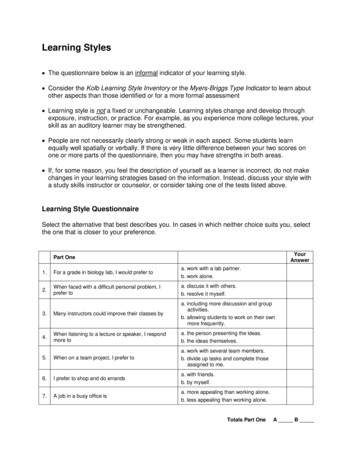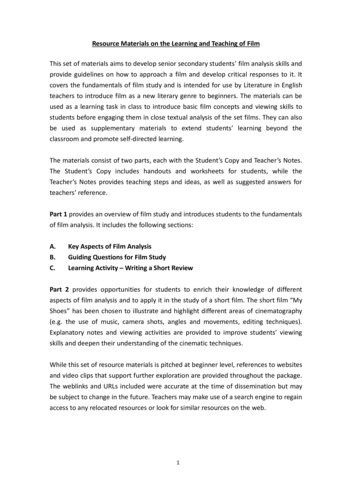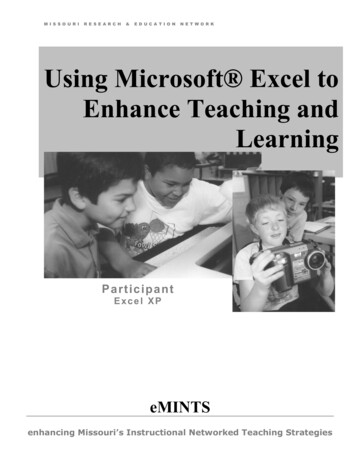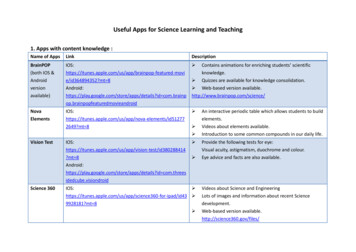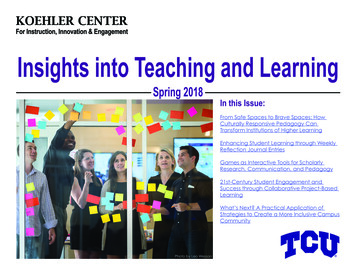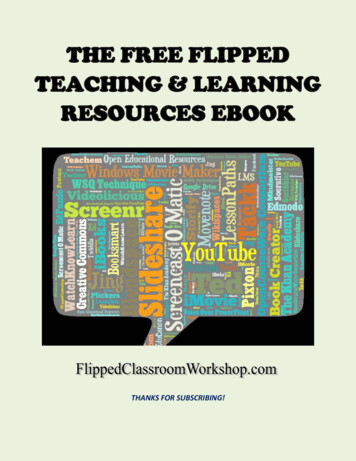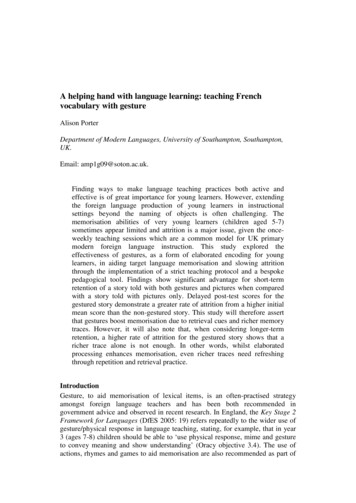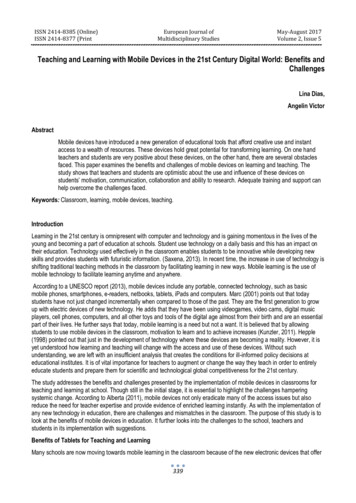
Transcription
ISSN 2414-8385 (Online)ISSN 2414-8377 (PrintEuropean Journal ofMultidisciplinary StudiesMay-August 2017Volume 2, Issue 5Teaching and Learning with Mobile Devices in the 21st Century Digital World: Benefits andChallengesLina Dias,Angelin VictorAbstractMobile devices have introduced a new generation of educational tools that afford creative use and instantaccess to a wealth of resources. These devices hold great potential for transforming learning. On one handteachers and students are very positive about these devices, on the other hand, there are several obstaclesfaced. This paper examines the benefits and challenges of mobile devices on learning and teaching. Thestudy shows that teachers and students are optimistic about the use and influence of these devices onstudents’ motivation, communication, collaboration and ability to research. Adequate training and support canhelp overcome the challenges faced.Keywords: Classroom, learning, mobile devices, teaching.IntroductionLearning in the 21st century is omnipresent with computer and technology and is gaining momentous in the lives of theyoung and becoming a part of education at schools. Student use technology on a daily basis and this has an impact ontheir education. Technology used effectively in the classroom enables students to be innovative while developing newskills and provides students with futuristic information. (Saxena, 2013). In recent time, the increase in use of technology isshifting traditional teaching methods in the classroom by facilitating learning in new ways. Mobile learning is the use ofmobile technology to facilitate learning anytime and anywhere.According to a UNESCO report (2013), mobile devices include any portable, connected technology, such as basicmobile phones, smartphones, e-readers, netbooks, tablets, iPads and computers. Marc (2001) points out that todaystudents have not just changed incrementally when compared to those of the past. They are the first generation to growup with electric devices of new technology. He adds that they have been using videogames, video cams, digital musicplayers, cell phones, computers, and all other toys and tools of the digital age almost from their birth and are an essentialpart of their lives. He further says that today, mobile learning is a need but not a want. It is believed that by allowingstudents to use mobile devices in the classroom, motivation to learn and to achieve increases (Kunzler, 2011). Hepple(1998) pointed out that just in the development of technology where these devices are becoming a reality. However, it isyet understood how learning and teaching will change with the access and use of these devices. Without suchunderstanding, we are left with an insufficient analysis that creates the conditions for ill-informed policy decisions ateducational institutes. It is of vital importance for teachers to augment or change the way they teach in order to entirelyeducate students and prepare them for scientific and technological global competitiveness for the 21st century.The study addresses the benefits and challenges presented by the implementation of mobile devices in classrooms forteaching and learning at school. Though still in the initial stage, it is essential to highlight the challenges hamperingsystemic change. According to Alberta (2011), mobile devices not only eradicate many of the access issues but alsoreduce the need for teacher expertise and provide evidence of enriched learning instantly. As with the implementation ofany new technology in education, there are challenges and mismatches in the classroom. The purpose of this study is tolook at the benefits of mobile devices in education. It further looks into the challenges to the school, teachers andstudents in its implementation with suggestions.Benefits of Tablets for Teaching and LearningMany schools are now moving towards mobile learning in the classroom because of the new electronic devices that offer339
ISSN 2414-8385 (Online)ISSN 2414-8377 (PrintEuropean Journal ofMultidisciplinary StudiesMay-August 2017Volume 2, Issue 5portability and ease of use on a budget. The new electronic devices include Netbooks, iPads, cell phones, iPods, ereaders and even PDAs. Recent research on use of various mobile devices in classrooms have revealed positive learningoutcomes for its use in classroom.Students are generally positive in using mobile devices for learning, which is essential for 21st century education (Wylie,n.d.). These devices enable students to control their individual learning and allow learners to switch learning contextsconveniently from formal to informal or personal to social. It keeps students engaged, attentive and motivated and allowsinteraction with the devices. Teachers also benefit from the use of these devices. There is evidence that mobile deviceshave encouraged independent learning making it easy for teachers to differentiate individual student needs and shareresources with students and among each other.For students, mobile devices are easy to use and attractive. These devices have larger screens, variety of apps, audioand video recording software, higher processing and battery power. Research on tablet use and adoption reports thatelectronic devices have a positive impact on students’ engagement with learning (Mango, 2015). The research showedthat students tend to spend more time and effort in learning tasks that are of interest to them. Clark and Lucking (n.d.)findings showed increased interest, creativity, enthusiasm, engagement, motivation, independence and self‐regulation,and improved productivity in students. Doing activities and discussions facilitated by the mobile device, students findlearning more fun as compared to a typical lecture-based classroom (Morrone et al, 2012).When tablets and iPads are used in classrooms, they have had a profound impact on teaching and learning according tothe research by Nishizaki, (2015). The research also showed that relationship in teaching and learning in the classroomchanges and becomes more student centered and student friendly allowing for more creativity of the student. Thenumerous apps available allow students to work independently, in groups and as part of the whole class, developing arange of knowledge and skills. With an increase in the use of devices, creative processes are possible as the boundariesbetween formal and informal learning blurs. There is emerging evidence to suggest that apps have a significant potentialto support the learning process (Shuler, 2009).Teachers can create interactive presentations, which include students’ observations and comments. Teachers can givelessons, monitor progress and stay organized. Simple-to-use and easy to create presentations with stunning animationsand effects. Productivity applications help students and teachers put together professional-looking documents,presentations, and spreadsheets no matter where they are. Teachers’ can directly write notes using these mobile devicesduring interactive discussion and these can be displayed on a projected screen for students. These notes can be saved,modified, uploaded and can be helpful to students who miss anything. Students can track their assignments, take notes,and study for finals using the notes.Tablets and iPads help students feel more confident in their learning after participating in technology-driven activities bypromoting active learning. Teachers could engage students in online discussion by linking all computers. The studentscan then take part in the discussion by writing on the screen. The mobile devices have the capacity to connect studentand instructor and create more active discussions and more constructive reflection (Morrone, 2012), that includesteacher-teacher, student-student, teacher-student, and student- teacher, what they are discovering is possible with thedevice. With a device, the classroom is always at the students and teachers fingertips with thousands of educational appsavailable to download.Mobile devices help forge closer connections between student and teacher. Both teachers and students have learnedand developed effectively through exploration and by wanting to share knowledge with each other (Burden et al, 2012).Teachers, students and parents report that the multiple communication features, routine availability and easy accessibilityof tablets in the classroom and in students’ homes make communication between teachers and students, and school andhome easier and routine. Positive evidence from parents such as: increased engagement and interest in learning, gainingknowledge and technology skills, more time spent on homework and more opportunity to make learning relevant andauthentic. Parents’ state that home-school communication improves with the introduction of mobile devices and lighterschool bags is a major benefit.The portability of mobile devices provides users with access to a broader and greater flexible source of learning materialsthan what is offered in current classroom settings. In addition, it can be used anywhere, in physical education, music,dance or even in the swimming lesson. With over thousands of apps available to download, teachers have access to an340
ISSN 2414-8385 (Online)ISSN 2414-8377 (PrintEuropean Journal ofMultidisciplinary StudiesMay-August 2017Volume 2, Issue 5abundance of learning materials for use on mobile devices such as the tablet. The teacher can easily update thestudent’s data even when outside class that is without going to the desk or school. Tablets and iPad are fitted withsensors, cameras, microphones, accelerometer, touch screen, on-screen typing, Voiceover and Talkback. These featureshave made these devices a popular device for teaching and learning for students of special needs such as students withautism or speech disorder, motor skills impairments, attention deficit hyperactivity disorder, dyslexia and visualimpairment. The touch screen enables them to access tablet effectively specially the student with motor skill impairmentsand voice output offers advantage to autism or speech disorder students. Mobile devices contribute to the development ofskills and connect students with and without disabilities (Dwight, 2013).Tablets and iPads have been overestimated as ‘revolutionary’ devices that hold great potential for transforming learning(Goodwin, 2012). One of the chief benefits of these mobile devices is that they enable learning anywhere, anytime. Thisallows a shift away from the traditional model where the classroom is the central place of learning driven by the teacherand limited to instruction within the school day. In deploying mobile devices, the teacher is no longer at the center of thelearning process and the instructional time can surpass the school day.The use of mobile devices provides many positive outcomes for students, staff, and the community. It not only improveswriting skills and gravity of students’ research but also increases student interest in learning and ownership of thelearning process. There are reductions in lecture/presentation instruction and an increase in project based learningactivities.ChallengesIn this digital era, more and more schools in many countries are taking advantage of these new mobile devices that offerportability and ease of use. Although the use technology in education is remarkable and has a positive trend, there is aneed for concern, as there are several obstacles that restrain the integration of technology (Vrasidas, Kyriacou, 2008).The existing process needs to be reassessed and new methods may have to be implemented to be used in classrooms.The approach of throwing these devices into classrooms to see what happens is bad and definitely will have negativeconsequences. Although the students are in favor of mobile devices, they too have concerns. However, there are someconcerns on the use of mobile devices in education raised by students, teachers and parents, which are discussed below.Technology is developing at a rapid pace and it is an ongoing process. Traxler (2010) considers that devices owned bystudents are not designed for education use and are poorly suited for learning. Initially tablets and similar devices weredeveloped for personal use but of late, they are designed for educational purpose. Innovative technology is developing ata rapid pace and a number of apps for learning and teaching purpose are being introduced. The management experiencesome stress in taking decisions in choosing the apps that are best for learning and teaching. As Melhuish and Falloon(2010) noted that "for an application to be a part of an individual's learning pathway they must be pedagogically sound indesign .rather than focusing solely on content, engagement or edutainment."In this era of digital technology, most children are immersed in digital technology. Homes are flooded with devices likesmart phones, tablets, Xbox etc. These children spend most of their time playing games and watching movies and it hasbecome a sedentary past time. However not all children have access to modern technology at home not only indeveloping countries but also in developed countries. Even if the developing countries introduced digital technology ineducational institutions, it is only limited to urban regions while the rural and poor people continue to lag behind, due tolack of investment, infrastructure and skilled teachers. The tablets are expensive to purchase and the cost ofmaintenance is even higher.Karsenti, & Fievez (2013) stated that students spend 76% of their time on using iPads outside the classroom on socialactivities, amusement and other recreation. Although students feel that use of tablet for learning would not intimidatethem, as it is an omnipresent constituent of their daily activities; yet even the tech-savvy students may consume moretime for learning activities until they are familiarized with the device. Not being competent in the use of mobile devicesmay frustrate them and they m
developed for personal use but of late, they are designed for educational purpose. Innovative technology is developing at a rapid pace and a number of apps for learning and teaching purpose are being introduced. The management experience some stress in taking decisions in choosing the apps that are best for learning and teaching. As Melhuish and Falloon (2010) noted that "for an application to .

